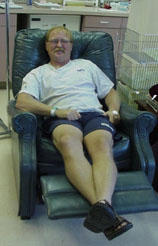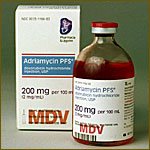
A night of sleep has worked wonders for me. I’m not exactly energetic, the morning after my surgery, but the porta-cath incision feels less painful. Claire and I drive over to Dr. Lerner’s office for our 9:20 a.m. chemotherapy appointment.
The first person we see is Diane, one of the chemotherapy nurses. Diane finds the porta-cath under my skin without too much difficulty – Dr. Gornish, the surgeon, has very helpfully penned an “X” to mark the spot – and inserts the IV needle. It hurts just a little more than the arm-pricks I’ve been getting, and she assures me that, once the surgical wound is fully healed, I’ll feel even less pain.
Dr. Lerner meets with us then, and explains the chemotherapy in detail. I learn that I’ve already made my first medication mistake: evidently I was supposed to start taking the allopurinol (the gout-preventing medicine) a couple of days before the first chemo treatment, not on the day of the treatment. Claire says she recalls this instruction, but I sure don’t: brain overload, I think. Dr. Lerner says not to worry: just take one today and double up with a second one this evening, then return to the daily dose. He’s evidently not going to stop this chemotherapy train, now that it’s finally ready to leave the station. We’re close enough to home that I ask Claire to drive and get the allopurinol prescription bottle for me, so I can take it that much sooner – and she very helpfully does so, before heading off to work.
 When we’re finished talking with Dr. Lerner, Diane leads me back to a small room, equipped with a comfortable lounge chair, IV pump and a television/VCR player. There’s a nice view out the window, looking across to the Silton Swim School, the pool where our daughter, Ania, took her swimming lessons years ago (although on this blustery, rainy winter day, who’s thinking about swimming?). I will soon come to appreciate the lounge chair with its electric-powered recliner and the television set: I’m going to be in this chair for more than eight hours today. (The chemo patient in the chair pictured here is nobody I know; it's just a photo I found in a Google image search. The chair looks just like the one I was using.)
When we’re finished talking with Dr. Lerner, Diane leads me back to a small room, equipped with a comfortable lounge chair, IV pump and a television/VCR player. There’s a nice view out the window, looking across to the Silton Swim School, the pool where our daughter, Ania, took her swimming lessons years ago (although on this blustery, rainy winter day, who’s thinking about swimming?). I will soon come to appreciate the lounge chair with its electric-powered recliner and the television set: I’m going to be in this chair for more than eight hours today. (The chemo patient in the chair pictured here is nobody I know; it's just a photo I found in a Google image search. The chair looks just like the one I was using.)First comes Benadryl, the antihistamine, administered through a small IV drip bag. This is to minimize possible allergic reactions to Rituxan. Next comes Aloxi, an anti-nausea medication, injected directly into the IV line. This is supposed to give me five days or so of anti-nausea protection. I sure hope it works.
Then comes Rituxan, the monoclonal antibody therapy. This takes by far the longest time of any of the medications I’ll receive today. Dr. Lerner has explained that the first Rituxan treatment must be administered gradually, so as to avoid the fever-and-chills side effects that often afflict first-time patients. Sure enough, after an hour or so of the medication I start to feel warm. When I tell Diane about it, she backs off the medication for a while, then re-starts it at a lower level. Throughout the rest of the day, the chemo nurses will gradually ramp the dose up, so as to empty the entire IV bag, carefully checking me for fever symptoms all the while.
I sit in the chair and try to read, although I feel exhausted and spend a good bit of time dozing. I read in dribs and drabs, watch some television and doze some more. Because the staff has been encouraging me to drink plenty of fluids, I need to make frequent trips down the hall to the bathroom, calling the nurse to unplug the IV pump, so I can push it ahead of me down the hall. I feel like a little kid again, having to ask permission to go to the rest room.
We’ve been clued in to bring a lunch, so from time to time I dip into the lunch bag Claire helpfully packed for me. I’m not feeling like eating very much, so I space it out through the whole afternoon.
 Finally, close to 5:00 p.m., the Rituxan is finished. Now, on to CHOP. This takes far less time than I expected. Two of the CHOP medications, adriamycin and vincristine, are administered directly into the IV tube, using a large syringe. Kay (the late-shift nurse who’s taken over from Diane) explains that she has to be very careful with the bright red adriamycin, because if it should spill onto the skin, its caustic effects can cause burns so severe that plastic surgery could be required. I wonder how the stuff doesn’t cause harm to the veins through which it passes – although I suppose it’s sufficiently diluted by the blood at that point.
Finally, close to 5:00 p.m., the Rituxan is finished. Now, on to CHOP. This takes far less time than I expected. Two of the CHOP medications, adriamycin and vincristine, are administered directly into the IV tube, using a large syringe. Kay (the late-shift nurse who’s taken over from Diane) explains that she has to be very careful with the bright red adriamycin, because if it should spill onto the skin, its caustic effects can cause burns so severe that plastic surgery could be required. I wonder how the stuff doesn’t cause harm to the veins through which it passes – although I suppose it’s sufficiently diluted by the blood at that point.Claire comes back in about the time I’m starting to receive the third chemo medicine, cytoxin. This stuff comes in a smaller IV drip bag, and it takes much less time to empty this one. This one irritates the bladder, Kay tells me, so I’ve got to keep pushing the fluids after I go home. The fourth CHOP medication, the steroid prednisone, is in pill form; I’ll start taking that one tomorrow morning, at home, and continue it daily for four days.
We finally finish at about 6:30. The last thing I do is make an appointment to return briefly to the office on Friday morning for an injection of Neulasta, a medication that encourages the production of white blood cells (a necessary corrective to the chemotherapy, which by then will be starting to depress the numbers of those cells).
After today, I’m more aware than ever what a slow-motion cure chemotherapy is. It took me a solid day just to receive the medications (although Diane assures me that, now that my body is used to Rituxan, future treatments will go more quickly). It’s going to be three more weeks till the next one. In the intervening time, I’ll come to experience the side effects: perhaps some nausea after the five-day dose of Aloxi wears off; hair loss beginning around day 13; and whatever other treats I may be in for.
My chemotherapy journey has begun.
2 comments:
I am as encouraged by today's blog as I was saddened by yesterday's, with the anaesthesia debacle. Does it feel good to have therapy finally underway? (despite all the "treats" you may or may not experience)
btw, if anyone is interested, I just printed out the full THIRTY-FOUR pages of this blog for a couple of our non-cyber-connected congregants. Wow! And every sentence and thought well crafted, nicely illustrated, and offering the view from the gurney, so to speak.
Prayers continue to come your way: all the congregation seems filled with anticipation as for a birth . . . waiting with bated breath for the outcome, yet understanding the true labor that is part of the journey . . . cheering each positive turn and weathering the downturns with sheer determination.
We know you are in good hands, both medically and spiritually, and we know your "true grit" is shining through. (No pressure there - some days may be grit-less! But you've inspired many with your faith and openness.)
shalom (peace and wholeness),
Robin
I thought of you often yesterday and throughout the day sent prayers heavenward for you. Your courage and faith is an inspriration to us all.
Post a Comment